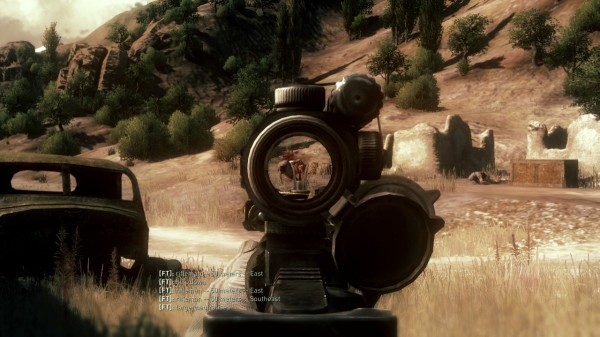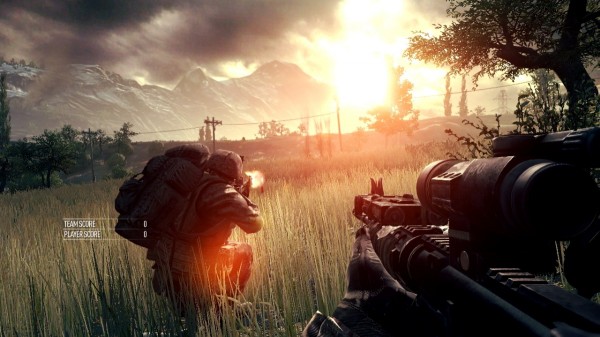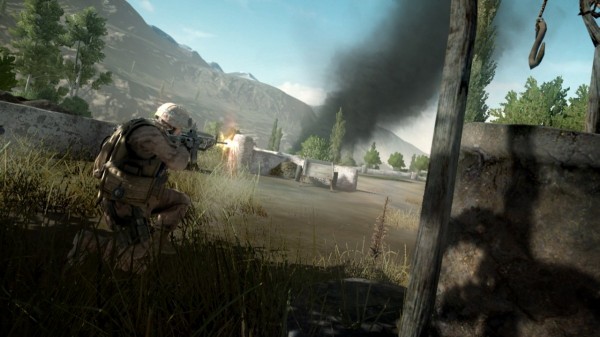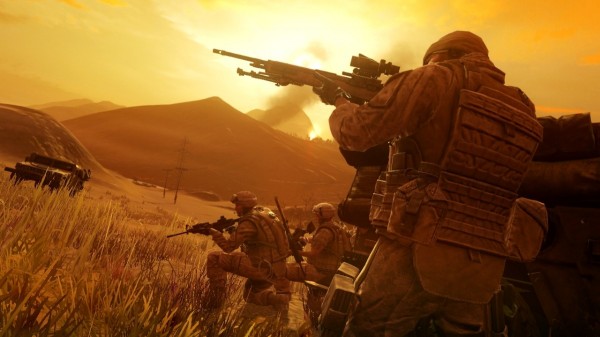Operation Flashpoint – Red River Xbox360, PS3, PC Review

Despite what Edwin Starr would have you believe; war (huh!) is in fact pretty good for inspiring all sorts of entertainment media. For every Oscar winning movie on the subject there is now a BAFTA award winning video game all based around the various awful conflicts that have plagued humanity since the first person figured out that killing is a pretty good way of getting rid of someone you don’t like.
In fact, within video games, they’re arguably the most popular genre on the market right now, with Activision’s monolithic Call of Duty series towering over all of them, with sales in the billions. EA’s Battlefield 3 is shaping up to be a real contender to the throne later this year, while THQ’s mediocre Homefront still sold an amazing amount, for such a generic game. Thing is, they’re all flights of fantasy. Thrill rides through the theatre of war, focusing on the “Boom” and “Bang” rather than the “Oh god, my squad member and good friend has been killed in a desert during an illegal war.”
The original Operation Flashpoint was a genuine first – A true to life military simulator. It didn’t feature exciting run and gun battles through gloriously rendered battlefields (unless you were doing something very wrong). Instead boasted a huge open landmass with objectives scattered throughout, realistic physics causing bullets to be affected by gravity, and a hell of a lot of hiking about. The main thing, however, was the realistic damage, which added a real tension to the proceedings. Wandering across a huge, empty field towards an enemy position was made significantly less boring knowing a sniper could pick you off with one well placed shot, and consequentially ending your game. Operation Flashpoint was an intense experience that no other game could provide. Thrills were replaced with fear. Excitement was replaced with tension, and us bearded man-children got a small glimpse into what it could be like to be in the middle of a warzone.
Instead of capitalizing on its success, everything went a bit wrong. Most of the team ended up leaving, creating their own company and putting out the incredible but utterly inpenetrable ARMA games. Operation Flashpoint 2 disappeared off the release radar for quite some time. When it finally appeared, as Dragon Rising, in 2009, it was met with a somewhat lukewarm reaction. The casual gamers couldn’t get to grips with the hardcore simulator aspects whilst the fans of the original were already onto ARMA 2.
Operation Flashpoint: Red River is going to come as a shock to some. Cutscenes, characters, dialogue and a running narrative. It is no longer the stoic representation of conflict that it used to be. You pick your member of a four-man fireteam and play through the main campaign mode, following a barebones overarching plot. Despite this, its still not a case of throwing you into a series of dramatic setpieces. This isn’t Bruckheimer – this is Generation Kill. The campaign missions aren’t elaborate story-telling events, they’re simple (in theory) missions that take place in a large map, with your team doing their part – completing a few objectives given to you in the field – and contributing toward the overall success. For instance, escorting a convoy of supply trucks isn’t just a case of tailing them from point A to point B. You’ll be tasked at sweeping villages along the way, seeking out anti-tank squadrons hidden in foothills and providing cover for other squads as they too work towards completing the main objective. Sure, it lacks the glitz and glamour of Call of Duty, but it’s no less exciting, and certainly makes EA’s lofty claims of realism directed at their latest Medal of Honor release look particularly amateur-hour.
The script is nowhere near as clever as it thinks it is, however, and some of the stabs at the sweary, xenophobic realism come across forced and a bit downright childish at times. One thing that is particularly good is Commander Knox’s constant reinforcing of his “ten rules of combat”. Whenever he gets the chance to, he will inform you of these commandments that will keep you alive on the battlefield. They’re part of his character, and his constant reinforcing of these becomes a running joke throughout the game, but by actually listening and paying attention to them, they teach you the absolute core fundamentals of success when playing Operation Flashpoint.
You’ll need them, too. One trait it maintains from the previous installments is that it is a damn unforgiving game. Poking your head out of cover without suitably suppressing your enemy will result in being shot quite a few times in the face. Stopping short of the standard regenerating health that almost every shooter these days requires, you now have to find cover and actively provide first aid to yourself, or have it provided by a team-mate. It is essentially the same as what you find in Call of Duty, Halo et al, only you have control over when you do it. It also takes a considerable amount of time to reach what is considered “full health”, so making sure you’re not going to get shot again whilst mid-process is paramount. Playing the game on normal difficulty gives you a considerable amount of help, in the way of a compass with enemy direction markers, a full working HUD with all the stuff you expect from a modern FPS game, as well as waypoint markers between each objective. It is easy to find yourself listlessly wandering between these, rather than taking up your own tactical approach to the objective in hand, but switching the difficulty to hardcore removes all of these aids, and even removes mid-mission checkpoints. This is where Operation Flashpoint truly excels. Playing on this difficulty requires you to consult your map, approach possible enemy positions using cover, and efficiently take them out. It is still far from being the ultra-realistic simulation that ARMA provides, playing in fact like one of the pre-‘Advanced Warfighter’ Ghost Recon games, and this is no bad thing at all.
Game progress is a lot more interesting than the disjointed campaign and multiplayer of Dragon Rising. As well as the campaign you’ve got Fireteam Engagements, a series of score-based skirmishes with different objectives. Rolling Thunder requires you to deliver a convoy to a base across enemy territory. Combat Sweep dumps your squad into a hostile filled map requiring you to exterminate all of them against the clock. The CSAR mission involves locating and extracting a pilot downed in enemy territory and the Last Stand mode puts you and your team against increasingly more dangerous waves of enemies, racking up the highest score possible and extracting before you’re all killed or your main base is overwhelmed. It is brilliant fun, and as the tanks and helicopters begin to be thrown at you you have to make a strategic decision to get out and cash in your score or stay to push further up the online leaderboard, but at the risk of dying and losing it all.
Completing objectives in any mode, as well as killing enemy troops, eventually causes you to level up whichever of the four classes you are currently playing as, and completing a mission will give you either a bronze, silver or gold award, based on your success in the objectives and time taken. These give you one to three stat points to add to your soldier, increasing things such as accuracy or the time it takes to identify a target. It is nowhere near as in-depth as some of its rivals, but still offers some reasons to change to different classes, unlocking new gear for each as you rise through the ranks.
Unfortunately, the A.I. means that playing these modes on your own isn’t always the most enjoyable experience. Like good soldiers, they’re fiercely loyal to your commands, to an absolute fault. Watch and cry as they ignore the three enemies stood next to your twitching body, getting themselves blasted to pieces because you decided to call them over to cure you after being incapacitated. Their path-finding on the large scale maps isn’t the greatest, and they’ll ocassionally waltz right out into direct fire, including your own. Sometimes they’ll just glitch completely and refuse to move, requiring a reload from the previous checkpoint to knock some life back into them.
Lucky, then, that there is one of the best “drop in/drop out” co op systems of any shooter built into Red River. At any point, you can open up your game for friends or the whole Live community to join you, whether you’re playing through a campaign mission or blasting through one of the fireteam engagement modes. Multiplayer is by far the best part of Operation Flashpoint, and having a dedicated bunch of mates in your fireteam and cranking the difficulty up to hardcore is one of the most unique and certainly one of the most intense experiences on any console.
Despite a few misjudged attempts at creating a realistic atmosphere, and not to mention some ropey A.I., Operation Flashpoint: Red River is a very good video game, as long as you’re willing to accept it on its own terms. Provided you not only have the patience for it, but also have a few like-minded friends to hand, there’s very little out there that will give you this kind of intense multiplayer experience, and certainly nothing else that will offer you it with such ease. If you’ve ever been on the fence about a realistic war game, bored of Call of Duty but intimidated by ARMA, the only starting point more accessible is your local military careers office.





